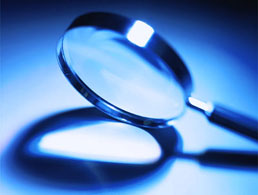Optical Instruments
Optical instruments

When we use an optical instrument, whether it be something very simple like a magnifying glass, or more complicated like a telescope or microscope, we're usually trying to make things look bigger so that we can easily see the finer details.
Optical instruments processes light waves to enhance an image for viewing, or analyzes light waves (or photons) to determine one of a number of characteristic properties. If we want to make things look bigger, we need to use converging mirrors or lenses. Diverging mirrors or lenses gives smaller images.
Early optical instruments

Early forms optical instruments includeded the telescopes and microscopes, which were developed in the 17th century. They were, in many instances, instruments of prestige as much as instruments of science, making up in finely tooled leather and polished wood for a flawed optical performance.
The formulae and methods of making good optical glass had not been discovered; the understanding of how defects in lens imaging could be cancelled out by an appropriate sequence of lenses made from different glasses was not available. Some instrument makers made trial and error progress but it took 200 years before this fundamental lack of knowledge was made good. In Britain, Michael Faraday spent five years of the 1820s extending the range of optical glass available. Microscopes and telescopes came of age in the nineteenth century.
Later developments

Numerous other optical devices were developed in the nineteenth century. Optical spectroscopy, the science of measuring the spectrum of light to find out the kind of atoms emitting the light, their properties and their environment, was a nineteenth century development. Optical glass prisms were the central component ofthe spectroscope.
In the nineteenth century the polarisation of light was discovered, a property of light scarcely perceived by the human eye. The Scottish physicist David Brewster made important discoveries about polarised light and another Scot, William Nicol, devised the standard method of producing polarised light at will, using his Nicol prisms.
Photographic cameras (see Photography) were developed from the camera of early centuries and were greatly improved as lens imaging became better understood. David Brewster also developed the lenticular stereoscope, in 1849, which became hugely popular in combination with stereoscopic pictures marketed by many photographers. Earlier (in 1817) Brewster had invented the kaleidoscope, another immensely popular optical toy which never had any pretensions to be a scientific instrument. The stereoscope, though, has serious uses. For example, it is from stereoscopic aerial pictures that the Ordnance Survey now constructs its very accurate topographic maps.